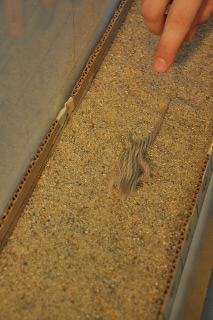
One major focus of reserach in the Evolutionary Functional Morphology lab is the study of form-function relationships. Organisms are composed of many interacting traits that must function together to allow an animal to carry out many tasks that are important for survival and reproduction. Because each task is redundantly affected by multiple traits and each trait must multitask, the relationships between traits and task performance are often complex. In our lab, we have developed the many-to-many mapping of form-to-function concept, which embraces the notion that redundancy and multitasking occur simultaneously and interact in any functional system with multiple parts and multiple functions. We have integrated this concept with the F-matrix approach, which allows us to quantitify these complex relationships, openning up many avenues of reserach.
Reserach in my lab is currently focused on studying lizards and frogs that engage in multiple modes of locomotion, like swimming, running, climibng, and jumping. Our goal is to relate performance atthese locomotor tasks to the underlying phenotypic traits. We wish to integrate classical body part measurement traits with muscle characteristics to gain a fuller understanidng of how performance at each mode of locomotion is affected, and to study how trade-offs between tasks affect the evolution of the underlying traits. Current resrearch is focusing on basilisk lizards and green frogs.
Form-function relationships can be affected by ecological context. Therefore, another avenue of reserach in the lab is investigating how different substrates affect both locomotion, and relationships between form and function. We are running lizards on a variety of substrates ranging from fine sand to boulders to test whether the traits that allow an animal to moving quickly change on different substrates, where the animals might have to use thier body differently. Prliminary findings suggest that animals are often able to maintain locomotor performance across substrates by modifying their locomotor kinematics, or how they move their bodies. We have pursued similar ideas in the frog jumping system, investigating how dehydration and body temperature, which are affected by environmental conditions in frogs, affect jumping performance and how animals behaviorally thermoregualte and hydroregulate. Our findings suggest that frogs will preferentially hydroregulate to stay hydrated, even when this is at the expense of their ability to jump well.
We are also interested in how form-function relationships change through ontogeny. As an animal grows, its body proportions change, and this may have functional implications. For example, although at birth, lengths of vertebrae are very similar along the vertebral column, as an animal approaches adulthood, vertbrae diverge in their lengths through differential growth, resulting in regionalization of the body. This can have functional implications for flexibility along the vertebral column. More generally, if animals grow allometrically, then we would expect form-function relationships to change with ontogeny as well.
